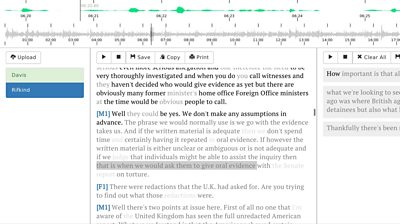
Radio production involves editing speech-based audio using tools that represent sound using simple waveforms. Semantic speech editing systems allow users to edit audio using an automatically generated transcript, which has the potential to improve the production workflow. To investigate this, we developed a semantic audio editor based on a pilot study. Through a contextual qualitative study of five professional radio producers at the ±«Óãtv, we examined the existing radio production process and evaluated our semantic editor by using it to create programmes that were later broadcast.
We observed that the participants in our study wrote detailed notes about their recordings and used annotation to mark which parts they wanted to use. They collaborated closely with the presenter of their programme to structure the contents and write narrative elements. Participants reported that they often work away from the office to avoid distractions, and print transcripts so they can work away from screens.
They also emphasised that listening is an important part of production to ensure high sound quality. We found that semantic speech editing with automated speech recognition can be used to improve the radio production workflow, but that annotation, collaboration, portability and listening were not well supported by current semantic speech editing systems. In this paper, we make recommendations on how future semantic speech editing systems can better support the requirements of radio production.
This paper was written in collaboration with the following authors: Mark D. Plumbley, Janko Ćalić and David Frohlich (Surrey). This paper was originally published in the International Journal of Human-Computer Studies, Volume 115, July 2018, Pages 67-80
White Paper copyright
© ±«Óãtv. All rights reserved. Except as provided below, no part of a White Paper may be reproduced in any material form (including photocopying or storing it in any medium by electronic means) without the prior written permission of ±«Óãtv Research except in accordance with the provisions of the (UK) Copyright, Designs and Patents Act 1988.
The ±«Óãtv grants permission to individuals and organisations to make copies of any White Paper as a complete document (including the copyright notice) for their own internal use. No copies may be published, distributed or made available to third parties whether by paper, electronic or other means without the ±«Óãtv's prior written permission.
